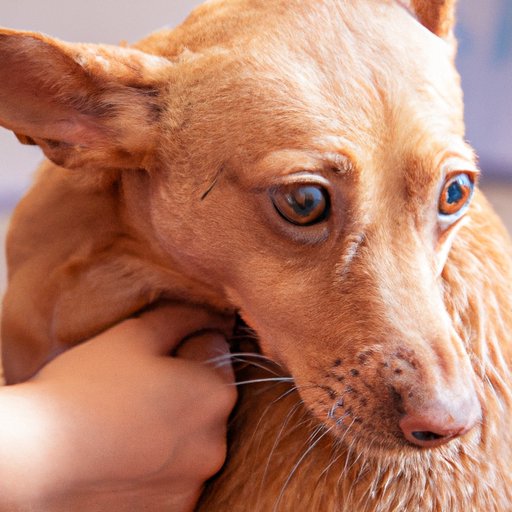I. Introduction
As dog owners, we love our furry friends and want to keep them healthy and happy. However, one challenge that can arise is dealing with hot spots or patches of irritated skin that dogs sometimes develop. In this article, we’ll explore the science behind the development of hot spots, how to prevent them, and effective home remedies for treating them.
II. The science behind hot spots: A look at the causes and triggers of canine dermatitis
Hot spots are areas of moist, irritated skin that can quickly become painful and itchy for dogs. They often appear as red, inflamed areas of skin and can be caused by a variety of factors, including allergies, infections, and parasites.
Allergies are a common cause of hot spots in dogs, and can result from food, pollen, dust, or other environmental factors. Infections, such as bacterial or fungal, can also lead to hot spots, as can parasites like fleas, ticks, and mites. Scratching and biting at the affected area can also exacerbate hot spots, leading to further irritation and infection.
III. Preventing hot spots in dogs: Tips and tricks to keep your furry friend’s skin healthy
The best way to prevent hot spots in dogs is by practicing good skin health through regular grooming and sanitation. This includes brushing your dog regularly to remove any loose hair and debris that can trap moisture and cause hot spots to develop. Bathing your dog regularly with a gentle shampoo can also help prevent hot spots, but be careful not to overdo it, as excessive bathing can lead to dry, itchy skin.
Watch your dog’s behavior and skin for signs of hot spots, such as excessive scratching, licking, or biting at a particular area. If you notice any red or inflamed areas of skin, take your dog to the vet to rule out any underlying health issues.
IV. How to soothe your dog’s itchy, irritated skin at home
If your dog develops a hot spot, there are several home remedies that can help alleviate their discomfort. One effective treatment is a topical ointment or spray, which can provide quick relief by cooling and soothing the affected area. Natural anti-inflammatories like aloe vera and chamomile can also help reduce redness and irritation. However, it’s important to consult with your vet before trying any home remedies, as some ingredients may be harmful to dogs.
V. Hot spots vs. other canine skin conditions: How to tell them apart and treat them accordingly
It’s important to be able to identify the difference between hot spots and other common skin conditions in dogs, such as mange, ringworm, and allergies. Mange is caused by mites and often results in hair loss and scaly skin, while ringworm is a fungal infection that appears as circular patches of hair loss and scaly skin. Allergies can result in itchy, red skin and can be triggered by a variety of factors, including food, pollen, or flea bites. Each condition requires a different treatment plan, so it’s important to consult with your vet for an accurate diagnosis and treatment options.
VI. Why breed may play a role in hot spot development: A breed-by-breed analysis
Some dog breeds may be more prone to developing hot spots than others, due to their skin type and other genetic factors. Breeds like Bulldogs, Shar-Peis, and Golden Retrievers are known to have sensitive skin and may be more susceptible to hot spots. It’s important to be aware of your dog’s breed and take appropriate steps to keep their skin healthy, including breed-specific grooming and nutrition.
VII. Taking a proactive approach: How to prevent hot spots before they start
Prevention is key when it comes to hot spots in dogs. Incorporating healthy nutrition, regular grooming, and avoiding known triggers can help keep your dog’s skin healthy and prevent hot spots from developing. It’s also important to partner with your vet and be proactive about your dog’s skin health, scheduling regular check-ups and addressing any potential issues before they become serious.
VIII. Conclusion
Hot spots can be a frustrating and uncomfortable issue for our furry friends, but with the right approach, they can be prevented and treated effectively. Remember to practice good skin health through regular grooming and sanitation, watch for signs of hot spots, and consult with your vet for an accurate diagnosis and treatment plan. By taking a proactive approach, you can keep your beloved dog happy and healthy for years to come.
